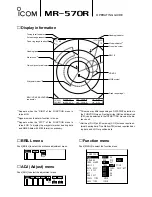
1.1
A Brief History of Marine Radars
5
CHAPTER 1
INTRODUCTION
WARNING
See the Important Safety and Product Information in the Installation Instructions for product
warnings and other important information.
All route and navigation lines displayed on the device are intended to provide general guidance to
identify proper channels, and are not intended to be strictly followed. Always refer to the navaids
and conditions on the water when navigating to avoid groundings or hazards that could result in
vessel damage, personal injury, or death.
Do not rely solely on the Simplified Target Tracking (TT) feature for collision avoidance. Always
pay attention to your surroundings, including other vessels, obstacles, water and weather
conditions. Never leave the helm unattended. You are responsible for the safe operation of your
boat.
1.1 A Brief History of Marine Radars
1.1.1 Basic Principles of Radars
Radar, originally an acronym for Radio Detection and Ranging, is a detection system that
determines the position and velocity of objects by transmitting radio waves outward and
processing the radio waves reflected off the objects.
1.1.2 Development of Marine Radars
Marine radars were developed during the period of the Second World War. Before its
development, seafarers had to rely on sound waves generated by a whistle, a gunshot, or
a bell sound to determine the direction and distance of obstacles when visibility is low.
Since its invention, marine radars are used to detect other vessels or land obstacles
and assist in navigation and collision avoidance at sea. A rotating antenna sweeps the
surface of water around the ship toward the horizon with a narrow beam of microwave
signals. The antenna then listens for bouncebacks of the signal to determine the bearing,
distance, and motion of detected targets based on the variations in the reflected signals.
The radar uses these information to map out the ship’s surroundings on the radar display
in a bird’s eye view.
1.1.3 Determining the Bearing
As the antenna rotates in the 360° circle, electronic pulses are sent out at slightly
different bearings. The signals, and their reflected echoes, travel at the speed of
light (roughly 161
,
785 nautical miles per second), and echoes are received almost
instantaneously when they reflect off objects. The bearing of a target is therefore the
angle of the antenna at which the echoes are received.
1.1.4 Determining the Range
The range, or the distance to a target, is calculated by multiplying half the speed of light
by the time difference between the transmission and reception of a signal. The speed is
halved because the signal traveled the distance twice (to and from the target).
Summary of Contents for CR 1522
Page 1: ...CR 1522 Marine Chart Radar Owner s Manual...
Page 30: ...CHAPTER 1 INTRODUCTION 28...
Page 44: ...CHAPTER 2 GETTING STARTED 42...
Page 62: ...CHAPTER 3 MENU AND SETTINGS 60...
Page 72: ...CHAPTER 5 APPENDICES 70...
Page 73: ......








































